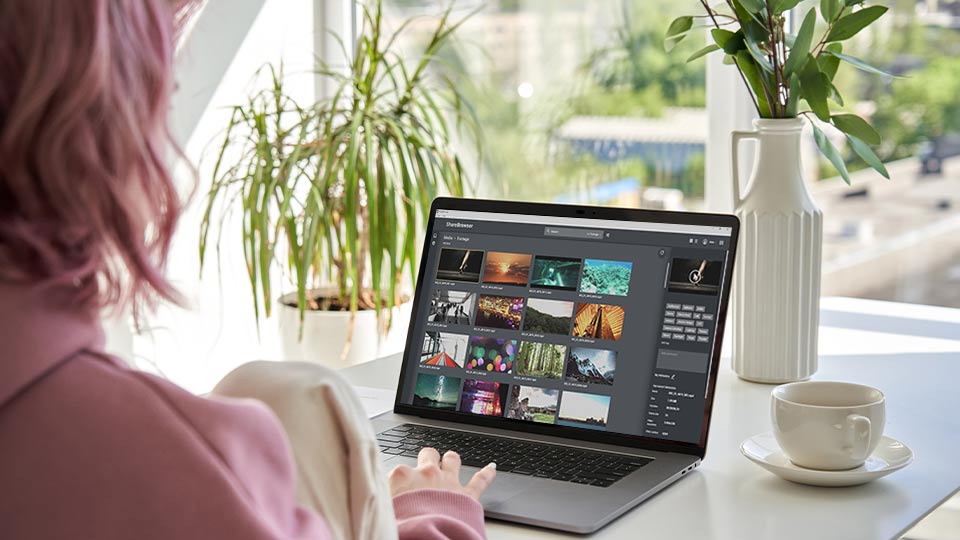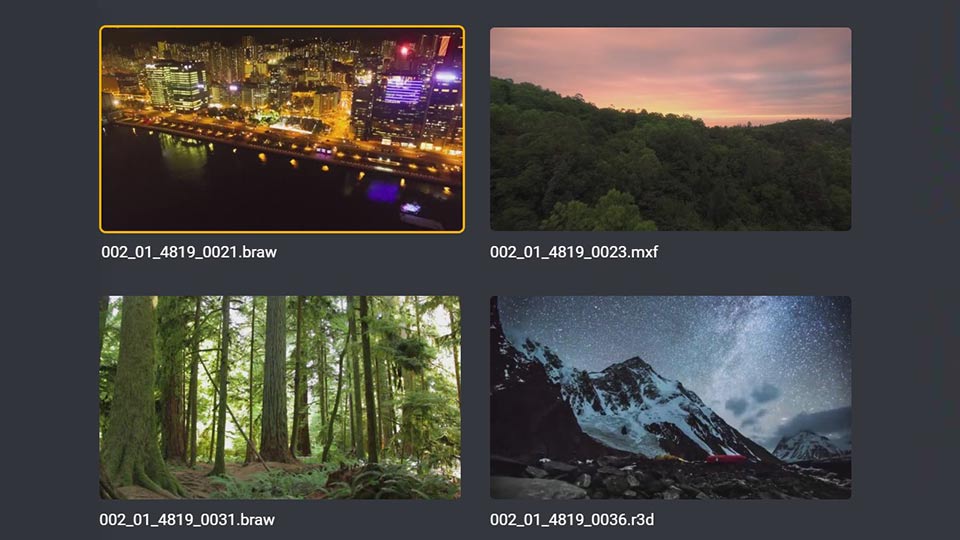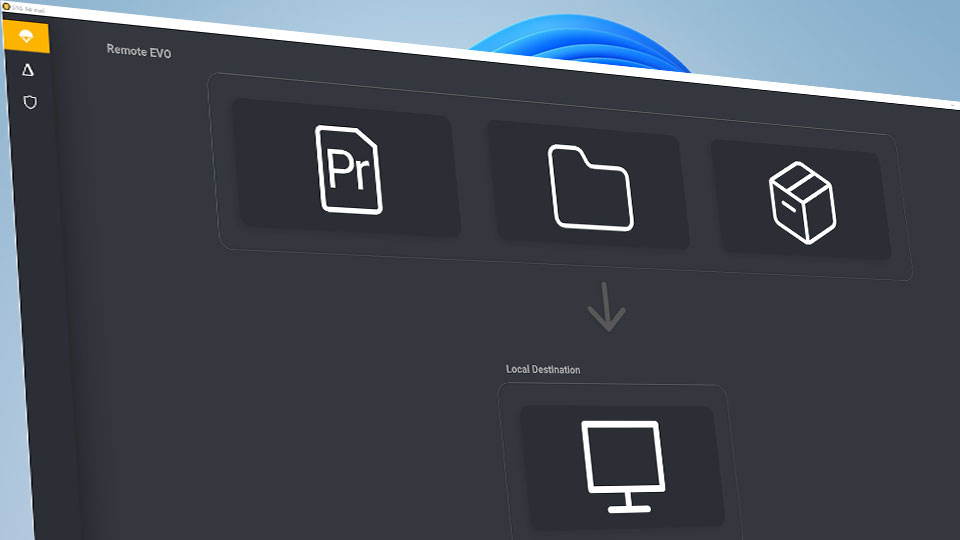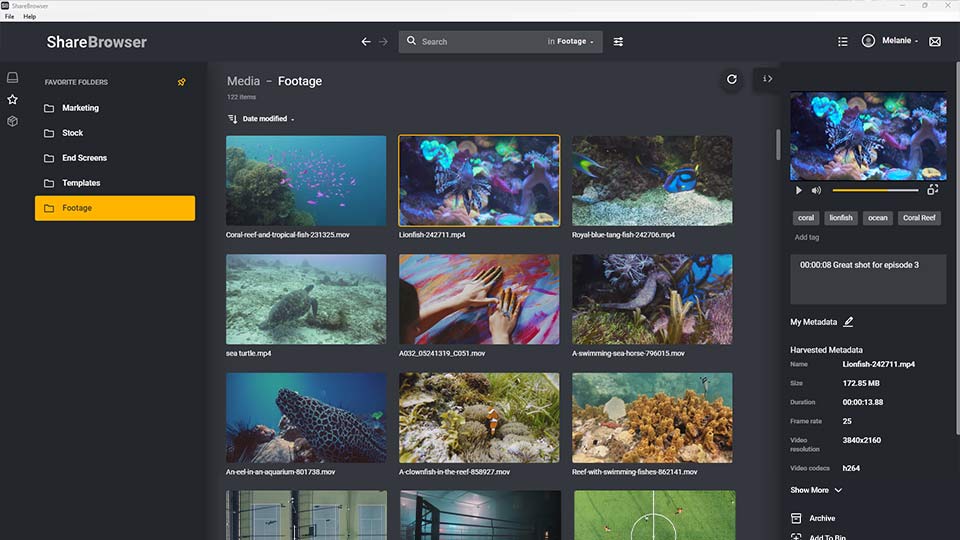Roses are R3D, violets are BRAW…

The EVO Suite’s latest update is a big one, bringing major improvements to the trinity of software tools included with the high-performance EVO media workflow solution. From transcoding R3D, BRAW, and ARRIRAW files, to an entirely new remote editing experience, this eye-catching batch of updates is built to speed up your post-production workflow, and add a little zen, too.
Let’s take a closer look at these workflow-enhancing changes, coming soon to an EVO near you.
The EVO Suite is the intelligent software toolset included with every EVO shared storage server. It comes with ShareBrowser media asset manager (MAM), Slingshot transcoding and automations engine, and Nomad remote editing tool—all included for unlimited users.
Better, Faster Transcoding With Slingshot
Slingshot (EVO’s transcoder and automations engine) is the workhorse of the EVO Suite, the unsung hero of your post-production workflow.
One of the biggest tasks that Slingshot takes on is transcoding large video files into proxy formats. Proxy transcoding is the process of taking high-resolution video formats (read: massive file sizes) and compressing them into proxy file formats perfect for previewing in ShareBrowser or editing remotely with Nomad.
Slingshot’s latest updates make these video transcoding tasks even faster—by up to 50% in some cases. But video transcoding isn’t just faster with the new Slingshot… It’s better, too.
Users can configure their proxy file settings to include custom watermarks and burnt-in timecode (BITC) in Slingshot, essential components for many remote editing workflows. Slingshot makes it easy to upload a watermark image, set the positioning, and add BITC (a.k.a. window burn) to proxy files, giving studios more control over their exported media and offline copies.

Seeing R3D (and BRAW and ARRIRAW)
For Slingshot’s next magic trick, it makes your raw media files… appear.
New transcoding options in Slingshot allow EVO users to preview RED RAW (.R3D), Blackmagic RAW (.BRAW), and ARRIRAW (.MXF) files as they browse and search their footage in ShareBrowser, EVO’s included media asset management software.
No more generic file type icons—users see the real deal, in bite-sized proxy format.
And with EVO’s Apple-certified ProRes transcoding, these ultra-high resolution raw camera files can be automatically transcoded into edit-ready ProRes proxies for optimized offline and remote editing anytime, anywhere.

Breathing New Life Into “Lifesaving” Nomad
If Slingshot is the workhorse of your workflow, Nomad is the Life Alert button.
When studio doors closed and workflows fell apart in 2020, Nomad (EVO’s remote editing tool) helped creative teams get back on their feet. Quickly coming to the rescue, Nomad has been called a “lifesaver” by many users, including DigitalTV and Guerrero Filmworks.
And now, Nomad is getting a total glow-up. The new GUI is clean, sleek, and easy on the eyes with a classic dark-mode aesthetic. Follow the simple, step-by-step instructions to select your input and output locations, intuitively laid out in an easy-to-follow structure.
Navigation is better too, with new features like a job history tab that tracks what you’ve used Nomad for in the past. This way users can easily delete jobs once they’ve finished for a decluttered look, or keep a running tab of what Nomad has done over time.

Nomad Delta For Premiere Pro Editors
EVO’s remote editing capabilities work with all file types and are a great resource for editors working in Adobe Premiere Pro, DaVinci Resolve, Final Cut Pro, Avid Media Composer, or any other video editing application that your creative team fancies.
For Premiere Pro users specifically, Nomad now has a little extra zing to improve your roundtrip remote workflow. That new special sauce is called Nomad Delta.
How does it work?
When you select a Premiere Pro project as your input source, Nomad will collect the project file and all associated proxy media for you to use offline for your remote editing job. Once you’ve finished your edit, Nomad Delta will identify exactly what new media has been added compared to the original project file. It then uploads only the new material back to EVO, without the extra weight of the unchanged elements in your project. It also retains the new media’s file structure on EVO so that it’s easy to toggle proxies on/off in Premiere.

ShareBrowser MAM Updates
EVO’s built-in media asset manager, ShareBrowser, is getting a ton of new features to help production teams create amazing content, faster, from anywhere. For starters, ShareBrowser’s new update helps teams improve their remote workflow with on-demand edit-ready proxy generation.
When navigating the MAM system and previewing your media, users can now create edit-ready proxies directly from ShareBrowser. Of course, Slingshot can automatically generate these edit-ready proxies for you. But if you haven’t set up automatic transcoding, or you need this particular proxy created before Slingshot has started the job, simply create the edit-ready proxy in ShareBrowser with a right-click menu selection.

The new ShareBrowser update makes it easier to access and navigate your files—even if those files aren’t stored on EVO. Users can quickly access their favorite storage locations on Google Drive, Dropbox, and other cloud, local, and network storage from ShareBrowser’s new Favorites tab. Simply right click and select “Add to Favorites” to bookmark any folder, local drive, cloud workspace, or other storage location you have access to.
And with updates to ShareBrowser’s NLE integrations, you can import your R3D files to your favorite video editing software, like Adobe Premiere Pro and After Effects, Final Cut Pro, and DaVinci Resolve Studio.
Here are more new features you’ll find in the latest ShareBrowser MAM update.
- Easily share links to searches, folders, files, bins, or any location you want to share
- New “back” and “forward” navigation buttons to improve the user experience
- API updates to reference tags and comments in 3rd party workflows
- Improved access to folder structures through search results
- HTTPS support compatible with EVO OS v.7
- Automatically unmount volumes on logout
- Multi-criteria search for custom metadata
- Sort folder contents by date modified
- Import and export user metadata

Work Remotely Twice As Fast
Lots of things can slow down your workflow when you work from home: slow internet from your housemates streaming Netflix, stray LEGO bricks on the floor… But your VPN connection shouldn’t be one of them.
If your VPN (or other remote connection to EVO) is keeping you and your remote collaborators from an efficient post-production workflow, VPN Accelerator can get you back on track.
VPN Accelerator is a brand-new feature for SNS Cloud VPN users that boosts remote workflow speeds by 2X, 3X, even up to 5X* compared to traditional VPN setups.
*Based on real-world, user-reported data.
Simply put, VPN Accelerator speeds up your remote workflow with EVO and the EVO Suite of workflow tools. It’s especially helpful for transferring data across long distances—such as between cross-country studio locations. But VPN Accelerator speeds up more than just data transfers. It accelerates everything over your remote connection to EVO.
Moving and copying files, previewing media, searching in ShareBrowser, working in Nomad, downloading proxies—and yes, transferring data—everything you do over the remote connection is faster with VPN Accelerator. Think of what your team could do with twice as fast remote connectivity to their EVO shared storage server and the EVO Suite.
Contact SNS today to schedule a personalized demo of the latest EVO Suite updates.
